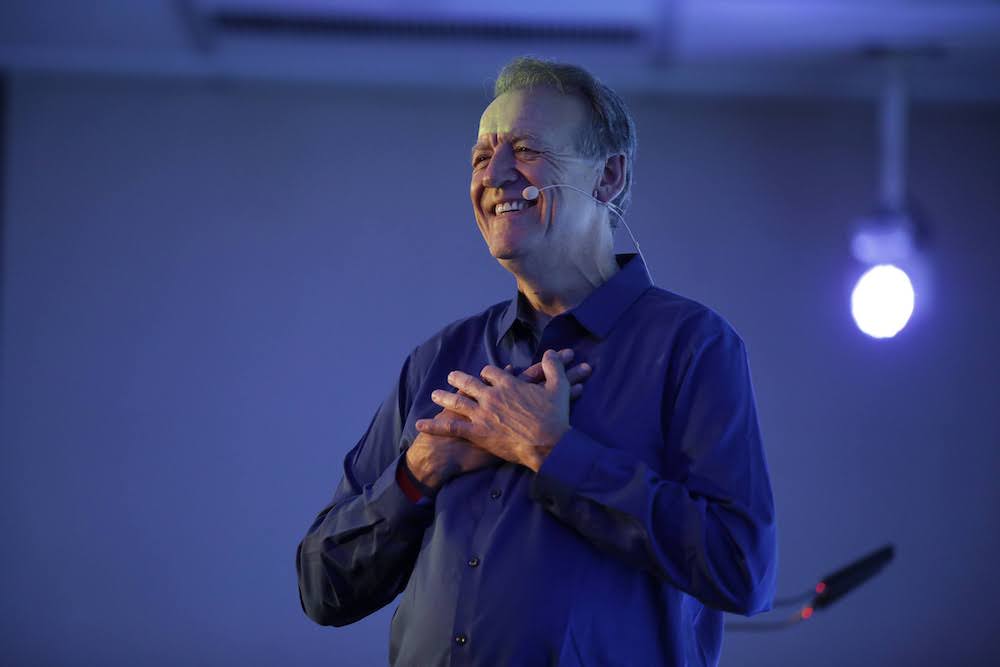A large-scale study by Harvard University found that, on average, our minds are filled with negative thoughts 47% of the time.
If you wonder why your brain is obsessed with things that are bad, especially events of the past, you should know that it’s part of its job to keep you safe.
The brain’s ability to default to the bad stuff of the past and the possible bad stuff of the future is called the Default Mode Network, and it was extremely valuable to our ancestors.
They needed to ruminate on the tiger that almost ate them yesterday and the tiger that might eat them tomorrow. That’s what kept them alive.
Does it mean that we are doomed to have negative thoughts and stress about the past and future because of the brain’s Default Mode Network?
Dawson Church, the founder of the National Institute for Integrative Healthcare in the U.S., studied mystics’ brains and found that they could shut them down when they entered the present moment.
It turns out, you can hack your brain and shut it down to achieve extraordinary states of happiness and bliss by activating happy chemicals in your brain.
Scanning the brain of the mystic
Forget the self and you will fear nothing … our lot in life is to … be hurled into inconceivable new worlds.
— Carlos Castaneda
Modern technological advances like electroencephalography (EEG) and magnetic resonance imaging (MRI) allow us to build a picture of what’s going on in people’s minds and brains in elevated states of consciousness.
Scientists can identify with great precision which areas of the brain are active and what frequency of electromagnetic activity they’re producing.
Over the past three decades, they have used these tools to study the brains of modern-day mystics—Buddhist monks and Franciscan nuns who have spent years in meditation, prayer, and contemplation.
Surprisingly, regardless of what religion these mystics come from, the elevated states of consciousness look very similar neurologically.
In his book Bliss Brain, Dawson Church, founder of the National Institute for Integrative Healthcare in the U.S., describes how the Default Mode Network is shut down in mystics’ brains.
He explains that the Default Mode Network shuts down when mystics enter the present moment, the only place where you can find true happiness.
Another critical difference in the minds of the mystics is an activation of the happiness and compassion networks.
“These adepts are extraordinarily happy. They’re so happy that ordinary people like you and me can hardly even imagine how happy they are,” says Dawson.
The brain wave of happiness
In studies of Tibetan monks, researchers measured an important brainwave called gamma, the wave of creativity, inspiration, integration, and happiness.
Dawson calls it ‘the genius wave’ because people in flow states have lots of gamma brainwaves.
Research shows that when mystics enter these elevated emotional flow states, the amount of happy gamma in their brains increases 25-fold.
In other words, mystics are 25 times as happy as the average person. Could you be 25% happier?
If you could, how can you take this quantum leap in happiness?

The 7 happy chemicals in brain known to science
There are seven critical neurochemicals produced in the brains of the mystics—the chemicals in the brain that make us extraordinarily happy and creative.
These seven happy chemicals, generated in the brain of the mystics during meditations, are seven proven keys to living in extraordinary mental and emotional states.
1. Dopamine: Motivational molecule
The latest research has found that dopamine doesn’t regulate pleasure as we would previously believe. It regulates motivation, causing you to initiate and persevere to obtain something positive or negative. So it’s your motivation molecule.
A network of regions in the base of your brain is called the “dopaminergic reward system.”
Dawson explains that it lights up when you anticipate a reward. Not when you get one. “It’s the anticipation that counts!” he says.
Dopamine and the reward system are highly active in addicts, as they play a role in all cravings, from chocolate to alcohol.
2. Oxytocin: The hug drug
Oxytocin is called the “hug drug” because it’s associated with touch, love, emotional intimacy, and bonding. It also facilitates generosity and trust within a group of emotionally close people.
It’s found in almost all mammals.
When you touch someone, your oxytocin rises. It can also be triggered by emotional intimacy, so it doesn’t require physical touch to boost oxytocin.
While oxytocin is produced in the brain, it has positive effects on the body. Unlike dopamine and serotonin, which work only within the nervous system, oxytocin affects the whole body.
So it’s a hormone rather than a neurotransmitter.
3. Norepinephrine: The attention focuser
Dawson calls it your inner caffeine, as it gives you a feeling of alertness and a jolt of energy. It’s like a triple espresso that keeps you focused, alert, and energized.
But here’s a paradox.
When you are stressed, your body activates the fight-or-flight response, and your brain produces bursts of norepinephrine, triggering anxiety. So norepinephrine is associated with both anxiety and attentiveness.
When you meditate, your brain produces norepinephrine, which reduces stress and keeps you awake.
Surrender to the process is the key.
4. Serotonin: The satisfaction molecule
Serotonin is your satisfaction molecule that works with dopamine as one team. Together, these two molecules reinforce goal-oriented behavior.
High serotonin levels are associated with feelings of both mental and physical wellbeing. This happy brain chemical is your natural mood regulator.
If your brain produces low serotonin levels, you are susceptible to greater aggression and impulsivity in both thought and behavior.
5. Nitric Oxide: The intensity powerhouse
Nitric oxide is your intensity powerhouse, as it gives you a feeling of focused intensity. It’s a by-product of oxytocin and is produced on demand. When you boost oxytocin, the brain automatically synthesizes more nitric oxide.
This tiny molecule has significant benefits:
- Promotion of normal blood pressure
- Protection against heart attacks
- Boosting immune function
- Antibacterial action
- Suppression of inflammation
- Maintenance of fluid balance
- Protection against diabetes
- In men, bigger erections
6. Beta-endorphin: Body ecstasy
Beta-endorphin is a powerful pain reliever produced by your brain’s pituitary gland, one of three endorphins produced in humans.
Endorphins diminish or block the perception of pain. For example, the pharmaceutical drugs morphine and codeine work the same way.
One study found that beta-endorphin is over 17 times more potent a painkiller than synthetic morphine when injected directly into the brain.
Beta-endorphin makes physical distractions fall away, leaving you with a deep sense of well-being in your body.
During meditation, your brain generates your body’s own morphine, one of the most pleasurable and addictive substances available to the human brain.
7. Anandamide: The bliss molecule
The feeling associated with anandamide is ecstasy. It’s also known as “the joy chemical” or “the brain’s own marijuana.”
Anandamide is part of a network called the endocannabinoid system that regulates many essential body functions, including:
- Pleasure and motivation
- Sleep
- Mood
- Appetite, digestion, and metabolism
- Learning and memory
- Reproduction and fertility
- Inflammation and immunity
- Cardiovascular system function
- The remodeling and growth of bone, nerves, muscle, and skin
Anandamide is associated with high levels of theta and gamma brainwaves. Gamma waves are sustained for long periods in advanced meditators.
17 proven ways to help you produce them naturally
- Meditate
- Listen to emotionally engaging music
- Contemplate emotionally engaging art
- Hug more
- Say “I love you” to someone you love
- Give presents
- Practice random acts of kindness
- Spend time with friends
- Pet an animal
- Do yoga
- Do brief but intense workouts
- Breathwork
- Take cold showers
- Engage in activities that require focus
- Spend time in nature
- Review happy memories
- Have sex
Just like mystics that can generate these happy brain molecules with the power of their brain, you too can rewire your brain’s Default Mode Network to feel extraordinarily happy.
If you want to learn science-based transcendent practices for mastering the seven key happy brain chemicals, join the Activate Your Mystic Brain Masterclass with Dawson Church.
You will find out how you can rewire your brain for near-immunity to stress, anxiety, and distractions.
It’s your quantum leap in happiness to take, so why not take it?








